
Suburban Electric Railway Association
Located at the COVENTRY ELECTRIC RAILWAY CENTRE, Rowley Road, Baginton, Warwickshire
Established
1996
The History Zone
Electrifying London
Early Tube EMUs
The Central London Railway were forced to take drastic action in relation to their early electric locomotives when complaints from landowners above the course of their line over the vibrations caused to properties when the trains passed below reached unacceptable levels. At first the CLR tried to modify the locos with geared motors and new suspensions whilst this had a fair degree of success the CLR decided to replace the locos with multiple unit motor coaches making use of a technology developed in America by Julian Sprague whereby with the use of low current control cables running the length of a train one driver in the leading cab could have simultaneous control over all the traction motors on the entire train formation. Trains that employed this technology were known as 'multiple units' and the CLR were to become the first railway in Britain to use them.
New motor coaches were constructed in 1903 and one was marshalled either end of a set of four original CLR loco hauled trailer cars to form a six car set. In due course some of the trailers were modified with the inclusion of a driving position at one end (driving or control trailer) so that trains could be split during off peak periods and run as three car sets. The layout of the passenger portion of the new motor coaches which started just behind the leading bogie was identical to that of the trailers being of saloon layout with a mixture of transverse and longitudinal seating, a gate end platform was provided at the inner end of the vehicle. The front portion of the vehicle was given over to the driving cab, behind which was an area as long as the leading bogie (of which both axles were motorised) which contained all the electrical switching and control equipment, whilst the passenger area was constructed and clad in timber the motor and cab end was clad in steel and gave the impression of being an amour plated head.
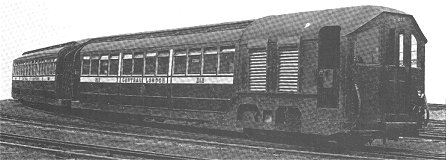
Between 1926 and 1928 all the CLR units had their gate ends replaced with air operated sliding doors to bring them in line with more modern stock operating at that time. The units continued to faithfully serve the Central Line long after the UERL takeover and were not finally withdrawn until July 1939.
Original Hampstead, Bakerloo and Piccadilly Tube Stock
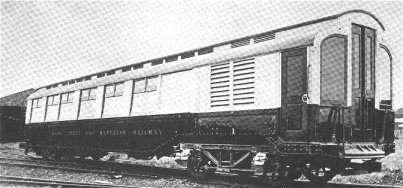
The stock for the three original lines opened by the UERL was built to the same basic style which itself followed the layout of those trains provided for the CLR, having saloon layout with gate end platform and the motor and switch gear compartment immediately behind the driving cab. The Bakerloo and Hampstead vehicles were built in Manchester by the American Car & Foundry Co. who purchased and equipped their works especially for the construction of these vehicles. The cars for use on the Piccadilly were built by two European manufacturers; The Hungarian Railway Carriage & Machinery Works in Raab, Hungary and Les Ateliers de Construction in northern France. The units began working from the opening dates of the railways concerned. Originally envisaged to operate with a six car formation they were in fact used in anything from two car formations upward as traffic demanded, but there was never more than two motor coaches in a formation at any time. A number of cars were converted to air door operation during the 1920s but they were eventually displaced by later deliveries of 'Standard' stock. The last operational pair of motor coaches saw use on the Holborn - Aldwych shuttle service in the late 1940s.
Stock Built For UERL Extensions
In 1914/15 twelve new motor coaches were built for the Bakerloo extension (pictured below). They made two significant departures from the tried and trusted layout of cab/switch comp/saloon/gate end of previous builds in that there was an additional passenger door located halfway along the saloon which featured an electric lock which the gateman operated prior to departure from any station. Secondly these cars were made entirely from steel which by this time had become a board of trade requirement for all new deep level tube stock.
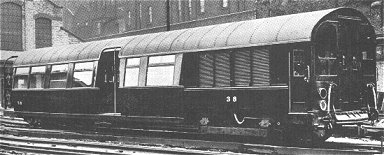
The CLR obtained 24 new motor coaches for use on their Ealing extension in 1915. These followed the same style as the Bakerloo stock mentioned above but with the main difference of not having gate end platforms but an enclosed end vestibule with swing passenger door. Prior to entering service on the CLR these cars were loaned to the Bakerloo due to late delivery of their own additional stock. Once in service with the CLR they were found to be incompatible with the original 1903 motor coaches and thus had to be marshalled at one end of a train with a like motor coach at the other end.
To work the services of Bakerloo over the LNWR line to Watford the UERL ordered a fleet of 36 motor coaches, 24 trailer cars and 12 control trailers. Due to the outbreak of the first world war these were not delivered until 1920-22. The trains were formed of a two and a four car set with the later having two trailers between two driving motor vehicles and the former being formed of a driving motor and control trailer car. The two car portion was detached from the formation in off peak periods. The layout of the cars followed the practice set by the 1915 CLR cars with all doors of the swing type and provided at each end and in the middle of the passenger saloons. In order to obtain board of trade permission to operate with a driving motor car in the middle of the formation it was necessary to alter the layout of the switch compartment to make provision for a through walkway for use by passengers in an emergency. Although designed to UERL standards these units were jointly owned by the UERL and the LNWR. In service the units proved to be not as reliable as expected and slower than other stock of the era, most were with drawn fron Bakerloo service by 1930 but three three car sets survived long after the bulk of the fleet was withdrawn under the ownership of the London Midland & Scottish Railway for use on the Watford - Rickmansworth and Croxley Green branches until 1939.
1919 Air Door Stock
The first cars to be built with air operated sliding doors were 20 trailer and 20 control trailer vehicles built between 1919 and 1922 for use on the Piccadilly line where the operated with a batch of original French built motor coaches that were provided with air operated sliding doors to match them. The cars were all built by Cammell Laird and featured saloon layout with entirely longitudinal seating. Four doors were provided on each side of the trailers, one at each end and two in the middle divided by a central pillar. The control trailers had the same arrangement by the door at one end was for use by the driver only. These cars remained in use until 1938.
The UERL Standard Stock 1923-1934
During the years above the UERL took delivery of a large number of driving motor, trailer and control trailer vehicles built to a standard design by four manufacturers; Met-Cam, Cammell Laird, The Birmingham Railway Carriage & Wagon Company and The Union Construction Company (A subsidiary of the UERL). Although there were a number of refinements made during deliveries of subsequent batches the vehicles are always refered to as the 'Standard Stock'. The layout drew inspiration from the air door trailers of 1919 except for the reappearance of some transverse seating and the pillar between the middle pair of doors was reduced in size on these units and eventually eliminated on later batches. Like all previous tube stock the standard stock featured a clerestory roof but it was more subtle.
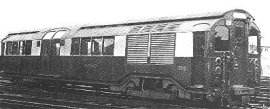
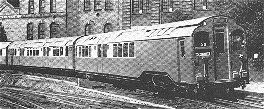
Above left: One of the first batch of standard stock cars compared to the picture on the right of one of the last.
The standard stock found use on all lines within the UERL group during a service life that lasted until the mid 1960s when the final cars were withdrawn. Among the innovations introduced on later batches was the introduction of electro-pneumatic braking which became standard on all subsequent tube and surface stock builds and was retrospectively built into earlier stock.
After withdrawal from the London Underground a number of cars were sold to British Rail where they enjoyed a further twenty years service on the Isle Of Wight.
